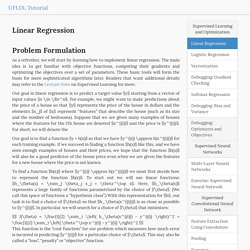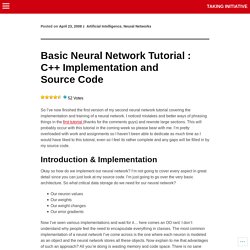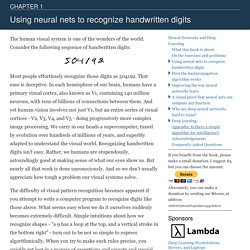

Electrical Engineering and Computer Science. Unsupervised Feature Learning and Deep Learning Tutorial. Problem Formulation As a refresher, we will start by learning how to implement linear regression.

The main idea is to get familiar with objective functions, computing their gradients and optimizing the objectives over a set of parameters. These basic tools will form the basis for more sophisticated algorithms later. Readers that want additional details may refer to the Lecture Note on Supervised Learning for more. Our goal in linear regression is to predict a target value starting from a vector of input values . Our goal is to find a function so that we have for each training example. To find a function where we must first decide how to represent the function . This function is the “cost function” for our problem which measures how much error is incurred in predicting for a particular choice of . Function Minimization We now want to find the choice of that minimizes as given above.
Differentiating the cost function as given above with respect to a particular parameter gives us: Basic Neural Network Tutorial : C++ Implementation and Source Code. So I’ve now finished the first version of my second neural network tutorial covering the implementation and training of a neural network.

I noticed mistakes and better ways of phrasing things in the first tutorial (thanks for the comments guys) and rewrote large sections. This will probably occur with this tutorial in the coming week so please bear with me. I’m pretty overloaded with work and assignments so I haven’t been able to dedicate as much time as I would have liked to this tutorial, even so I feel its rather complete and any gaps will be filled in by my source code. Introduction & Implementation Okay so how do we implement our neural network? Our neuron valuesOur weightsOur weight changesOur error gradients Now I’ve seen various implementations and wait for it… here comes an OO rant: I don’t understand why people feel the need to encapsulate everything in classes.
The other common approach is to model each layer as an object? Initialization of Neural Network The Training Data Sets. Neural networks and deep learning. The human visual system is one of the wonders of the world.

Consider the following sequence of handwritten digits: Most people effortlessly recognize those digits as 504192. That ease is deceptive. In each hemisphere of our brain, humans have a primary visual cortex, also known as V1, containing 140 million neurons, with tens of billions of connections between them. And yet human vision involves not just V1, but an entire series of visual cortices - V2, V3, V4, and V5 - doing progressively more complex image processing.
The difficulty of visual pattern recognition becomes apparent if you attempt to write a computer program to recognize digits like those above. Neural networks approach the problem in a different way. And then develop a system which can learn from those training examples. The Nature of Code. “You can’t process me with a normal brain.” — Charlie Sheen We’re at the end of our story.

This is the last official chapter of this book (though I envision additional supplemental material for the website and perhaps new chapters in the future). We began with inanimate objects living in a world of forces and gave those objects desires, autonomy, and the ability to take action according to a system of rules. Next, we allowed those objects to live in a population and evolve over time. Now we ask: What is each object’s decision-making process? The human brain can be described as a biological neural network—an interconnected web of neurons transmitting elaborate patterns of electrical signals. Figure 10.1 The good news is that developing engaging animated systems with code does not require scientific rigor or accuracy, as we’ve learned throughout this book. 10.1 Artificial Neural Networks: Introduction and Application Computer scientists have long been inspired by the human brain.
Show Raw. Neural networks and deep learning. 15 Steps to Implement a Neural Net – code-spot. (Original image by Hljod.Huskona / CC BY-SA 2.0).

I used to hate neural nets. Mostly, I realise now, because I struggled to implement them correctly. Texts explaining the working of neural nets focus heavily on the mathematical mechanics, and this is good for theoretical understanding and correct usage. However, this approach is terrible for the poor implementer, neglecting many of the details that concern him or her. This tutorial is an implementation guide. I tried to make the design as straightforward as possible. To keep the implementation simple, I did not bother with optimisation. The brief introduction below is a very superficial explanation of a neural net; it is included mostly to establish terminology and help you map it to the concepts that are explained in more detail in other texts. Preliminary remarks and overview What we are doing Now in heaven, there is a function for exactly that task – we give the function the features, and it spits out the class.
Representation Overview.